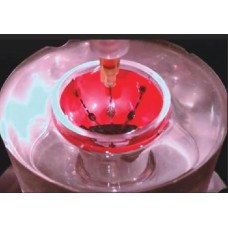A Bionic Eye Closer to 3D printer Reality
The dream of producing a bionic eye has taken a step closer thanks to silver. The challenge of making such a prosthetic has always been to layer light-sensitive materials onto an orb without the distortion inherent in placing two-dimensional objects even thin ones like wires onto a rounded surface.
Researchers at the University of Minnesota claim to be the first to use a 3D printer to overlay light receptors on a hemispherical glass surface. Michael McAlpine, a coauthor of the study 3D Printed Polymer Photo detectors and Associate Professor of Mechanical Engineering, said in prepared remarks: “Bionic eyes are usually thought of as science fiction, but now we are closer than ever using a multi-material 3D printer.”
Using a custom-made 3D printer, the research team took a base ink of silver particles and sprayed it on the glass surface. Instead of running down the curved surface like other materials, the silver ink stayed where it was applied and did not drip. They then used semiconducting polymer materials to print photodiodes, devices that convert light into electricity. The process took an hour.
McAlpine noted that he was surprised by the efficiency they obtained in converting light into electricity 25 percent. He added: “We have a long way to go to routinely print active electronics reliably, but our 3D-printed
Semiconductors are now starting to show that they could potentially rival the efficiency of semiconducting devices made in micro fabrication facilities. Plus, we can easily print a semiconducting device on a curved surface and they can’t.”
McAlpine and his team are known for integrating 3D printing, electronics, and biology on artificial surfaces, including their work in producing sensitive bionic skin. Future research will focus on producing a prototype with a greater number and more efficient light receptors. They also will be working on a way to print on a hemispherical surface that is softer than glass so it can be implanted into a human eye socket.
The team’s research was funded by the U.S. National Institute of Biomedical Imaging and Bioengineering of the National Institutes of Health, The Boeing Company, and the Minnesota Discovery, Research and InnoVation Economy (MnDRIVE) Initiative through the State of Minnesota.




